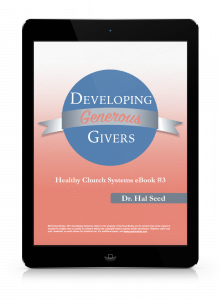
You may smirk at my simple, and profound, paradox of church giving:
- The vast majority of people want to give.
- They just don’t.
- And there are lots of reasons why.
Some don’t give because they don’t know that they should. Others don’t give because they’ve never been taught what the Bible says.
Many make assumptions about how a church works without understanding where its finances are supposed to come from.
Even seasoned Christians can be wary of giving.
So the question is: how can you overcome the resistance to giving that pushes against the desire to give? And the follow-up question: if you manage that, is it possible to unlock the giving potential of your church?
Your first step: understand that not everyone gives with the same motivation.
5 Reasons Why People Give
What motivates you may not motivate me. As you teach people to give, it helps to understand their reasons.
1. Some give because of relationship.
People will give money to an organization because they have a relationship with the people there.
2. Some give because of vision.
A compelling vision inspires people to give (Proverbs 29:18, KJV). People want to be part of something bigger than themselves. Clear vision helps people understand what God wants to do through his church.
3. Some give because of need.
People will give to a need, as evidenced by the outpouring of donations after a hurricane or other natural disaster.
4. Some give out of obedience.
Many people give because they understand God’s directive to give (Malachi 3:9-10; Proverbs 3:9-10; Luke 6:38).
5. Some give because of education.
People will give when they have been taught what God’s Word says about money.
As you instruct on giving, recognize that some reasons will make more sense to a certain segment of your congregation, while others respond to a different drum. When possible, touch on each of these motives when you explain stewardship to people.
People need to be led, taught, inspired, encouraged, given incentive, celebrated, and helped with their personal money-management in order to become faithful and generous stewards.
Next, the actionable steps.
10 Ways to Reach your Church’s Giving Potential
1. Make sure you are tithing.
God is always more interested in teaching the leader than having the leader teach the people. If you haven’t studied the principle of firstfruits giving, I encourage you to read Robert Morris’ The Blessed Life. It will inspire and educate you! The Law of the Harvest says you reap what you sow.
It’s almost guaranteed that if you don’t tithe, the church won’t be financially healthy.
2. Make sure your staff and Board are tithing.
Likewise, if your leaders haven’t learned to tithe, the Lord will teach them before he lets you teach your members. At New Song, we talk about tithing with all staff members before hiring them and all Board members before submitting their names for a vote of the congregation.
We also make sure every member of our counting and accounting teams are tithers. We want the people who handle our offering to be qualified to handle it well. I encourage you to verify that a person is tithing before you allow them to join any teams related to finances in your church.
3. Have a Christmas offering.
Generosity reaches its peak during the Christmas season. Churches who take an annual Christmas Offering or Year-End Offering find that their members will give to a specific cause over and above their normal giving. In most churches, the Christmas Offering totals 5 to 20 percent of the church’s annual budget. Imagine being able to add ten percent to this year’s budget without offending anyone!
 An informed fundraiser once told me that Americans gives to an average of six charities between Thanksgiving and Christmas. If you believe your church is worthy, it ought to be one of those charities.
An informed fundraiser once told me that Americans gives to an average of six charities between Thanksgiving and Christmas. If you believe your church is worthy, it ought to be one of those charities.
Recognize that your Christmas Offering has to compete with all the chatter from other non-profits, so you must plan and prepare for it carefully. Successful Christmas Offerings start with thinking and prayer in September and end with thanking and reports in February.
A few years ago I created a master class called the Christmas Offering Kit. This kit will walk you through the simple but important steps to ensure that your offering is well planned, directed to the right priorities, honors your donors, and furthers your goal of growing mature financial stewards.
Learn More about the Christmas Offering Kit
4. Take your offering slowly.
Because pastors are often uncomfortable talking about money, sometimes we don’t give people time to prepare for the offering or help them understand what the offering is for.
At New Song, immediately following the sermon, the service host will say, “Now is the time when we take our worship up a notch. Last week we saw eleven people come to Christ. Don’t you love knowing that your giving changes lives for eternity? That’s why we love investing in his work around here.” Or, “Last month, we were able to give away 1,000 pounds of food to needy families.” Or the like.
Take a full minute or two to introduce the offering, explaining how people can give, why they would want to give, what God says about giving, and/or how giving is an investment in God’s work. Invite a tither to tell their story of blessing occasionally.
When you take the offering slowly, your congregation has time to get ready.
5. Quarterly, ask non-givers to give.
Somewhere between forty and seventy percent of your church members fall into the “non-giver” category.
They aren’t including God in their financial priorities, experiencing his blessings from giving, laying up treasure in heaven, or obeying God’s commands to give.
Most people grow one step at a time. Help them take a small step by asking them to give their first gift.
Mark your calendar with a note that on the first weekend of every quarter, you will ask non-givers to make their first gift.
While introducing the offering, say, “This morning I want to encourage those of you who’ve never given to make your first gift to God today.” Quote a blessing or promise from Scripture about giving. Matthew. 6:19-21; Luke 6:38; Proverbs 3:9-10; Malachi 3:10-11 are a few possibilities.
6. Quarterly, ask givers to tithe.
Help your givers to take a small step as well. On the second weekend of the quarter ask your givers (those who give occasionally, or a fixed amount below the tithe) to take your “Ninety Day Tithe Challenge.”
Moving from giving to tithing can seem like a big step for some, so shrink the size of the step by guaranteeing the results.
Here’s what you say:
Just before the offering, read Malachi 3:9-11. “This is the only time in Scripture when God allows people to ‘test’ him. Tithing is a faith step. It’s like planting seeds for a harvest. You sow. You wait ten or twelve weeks. Then you reap. You don’t reap the day you sow, there’s an interval in between.”
“We believe so strongly in this principle that we will guarantee your investment. If you will tithe faithfully, from every paycheck for the next ninety days, if, at the end of those ninety days you do not feel blessed by God in whatever way you define a blessing (which could be monetary or otherwise), as long as you’ve documented your giving by doing it online, by check, or filled in your information on your giving envelope so we can verify what you’ve given, we will refund your full tithe.”
No one has ever asked for their money back.
7. Enlist more volunteers.
Take a moment to mentally look over your congregation as they’re seated for worship. About half of them are non-givers.
Now, think through your teams of volunteers. Nine out of ten of them are givers.
Volunteers become invested in their ministry.
Where your treasure is, there your heart is also. Which is why volunteers find themselves giving – their hearts become invested in their ministry!
What’s the best way to enlist volunteers?
We cover that in eBook #5 in this series: Placing and Keeping Great Volunteers. In one sentence, volunteers are invited, oriented, cared for and celebrated.
8. Encourage people to automate their giving.
Encourage people to automate their giving by having their bank automatically send a check or direct deposit to your church’s bank account once or twice a month. Even the best-intentioned tithers miss an offering by accident once in a while. They mean to give, but they got sick, went out of town, or something happened where they just forgot and didn’t notice soon enough to make it up.
During the month of May, create an automated giving campaign.
Remind your people that summer is coming and they don’t want to fail at their faithfulness to the Lord’s work. Place an automated giving brochure in your bulletin and talk about it every week for a month. Bring someone on stage to give a testimony about how this practice has increased their faithfulness. Make a video of how easy it is to automate one’s giving.
9. Cultivate a relationship with high capacity givers.
Every member of your church needs a peer to relate to. Pastor, you are probably the person most capable of ministering to people with high capacity to give.
Man up to this challenge and befriend and appreciate those who give a disproportionate amount to your church just as you would befriend and appreciate those who serve or lead at extraordinary levels. Just don’t be tempted to prefer them above others (James 2).
A very astute pastor once told me that in most churches, seven families contribute thirty percent of the offerings.
He claimed that it’s a law, like the Pareto Principle (where eighty percent of the work is always done by twenty percent of the people.) According to this law, your top-giving family probably contributes ten percent of the church’s budget.
Two other families contribute five percent each, and four more families contribute two-and-a-half percent each. Total it up and that comes to thirty percent. If this is true, those seven families are enabling a lot of ministry in your church and are probably some of the best money managers you’ve got.
People who have the capacity to write large checks often have unique stewardship challenges. They need the wisdom and encouragement of a spiritually mature leader to help them navigate those challenges.
10. Educate your high capacity givers.
Money is such a personal thing in our culture that the only way you will be able to give good counsel to your biggest givers is if you become close enough friends that they can confide in you.
Pastors who find someone who makes money well ought to help them learn to manage their money well, and give it well. Fuel their spiritual gift of giving with books, podcasts, and other resources that will teach and encourage them to develop and increase their spiritual gift and the money-related skills involved with it.
Now What?
 Start at the top of the list and work your way down. Or start with the idea that will have the biggest impact. Or start with the easiest idea to implement for a quick win.
Start at the top of the list and work your way down. Or start with the idea that will have the biggest impact. Or start with the easiest idea to implement for a quick win.
To learn more about developing your church’s financial health, pick up my ebook: Developing Generous Givers.
Further Reading
 Hal Seed is the founding and Lead Pastor of New Song Community Church in Oceanside, CA. He mentors pastors who want to lead healthy, growing churches with resources at www.pastormentor.com.
Hal Seed is the founding and Lead Pastor of New Song Community Church in Oceanside, CA. He mentors pastors who want to lead healthy, growing churches with resources at www.pastormentor.com.
Start Here to learn more about the resources available for you at PastorMentor.
Leave a Reply